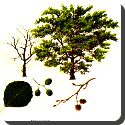 Alder, Black — Black Alder, European Alder or Common Alder is an alder tree native to most of Europe, including all of Britain, Fennoscandia and locally in southwest Asia.
Alder, Black — Black Alder, European Alder or Common Alder is an alder tree native to most of Europe, including all of Britain, Fennoscandia and locally in southwest Asia.
Alnus glutinosa thrives best in moist soils, and grows under favourable circumstances to a height of 20-30 m, though often less. It is characterized by its 5–10 cm short-stalked rounded leaves 6–12 cm long, becoming wedge-shaped at the base and with a slightly toothed margin. When young they are somewhat glutinous, whence the specific name, becoming later a glossy dark green. As with some other plants growing near water it keeps its leaves longer than do trees in drier situations, the glossy green foliage lasting after other trees have put on the red or brown of autumn, which renders it valuable for landscape effect. As the Latin name glutinosa implies, the buds and young leaves are slightly sticky with a resinous gum.
The monoecious flowers are wind-pollinated catkins: the slender cylindrical male catkins are pendulous, reddish in colour and 5–10 cm long; the female are smaller, 2 cm in length and dark brown to black in colour, hard, somewhat woody, and superficially similar to some conifer cones. When the small winged seeds have been scattered the ripe, woody, blackish cones remain, often lasting through the winter. The alder is readily propagated by seeds, but throws up root suckers abundantly.
It is important as coppice-wood on marshy ground. The wood is soft, white when first cut and turning to pale red; the knots are beautifully mottled. Under water the wood is very durable, and it is therefore used for piles. The supports of the Rialto at Venice, and many buildings at Amsterdam, are of Alder wood. It is also the traditional wood burnt to produce smoked fish and other smoked foods, though in some areas other woods are more often used now. Furniture is sometimes made from the wood, and it supplies excellent charcoal for gunpowder. The bark is astringent; it is used for tanning and dyeing.
 Kids Portal For Parents India Kids Network
Kids Portal For Parents India Kids Network






